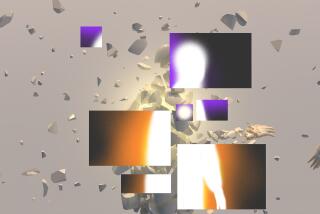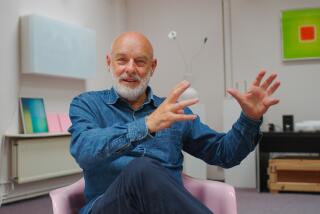The neural hit parade
In his 10th book, neurologist and author Oliver Sacks turns his formidable attention to music and the brain. More than ever, his focus and tone are ruminative, though still probing. He doesnât stint on the science: Studies are cited, sources duly footnoted, the work of others encouragingly acknowledged. But the underlying authority of âMusicophiliaâ lies in the warmth and easy command of the authorâs voice.
Sacks has an expert bedside manner: informed but humble, self-questioning, literary without being self-conscious. He uses anecdotes and thumbnail sketches to deftly illustrate physiological explanations that lie behind a behavioral continuum extending from bizarre self-defeating pathology to the very heights of creativity. âEven the most exalted states of mind . . . must have some physical basis . . . in neural activity,â he writes.
In a roundabout way, âMusicophiliaâ could be a follow-up to Sacksâ 2001 book, âUncle Tungsten: Memories of a Chemical Boyhood.â In that memoir, the physician reconnected with his science-geek English childhood during the darkest part of World War II, applying the same probity and insight he brought to the case studies in âAwakeningsâ (1973) and âThe Man Who Mistook His Wife for a Hatâ (1985).
Those two books, Sacksâ best known, strongly resemble short story collections; âUncle Tungstenâ follows the narrative path of traditional autobiography. Despite, or perhaps because of, its musical bent, âMusicophiliaâ is looser, more casually structured, even discursive at times, with long, considered essays abruptly followed by sound-bite briefs. It adds up to a personal record of Sacksâ working life, recollected through the filter of his abiding adult enthusiasm for classical music. Heâs an accomplished amateur pianist and inveterate concertgoer who also has treated a number of gifted musicians in his medical career. Looking back to his earlier cases, reconsidering his published work for its musical content, Sacks makes of âMusicophiliaâ not so much a greatest-hits collection as a purposeful set of remixes.
Take the revisited case of Dr. P, a middle-aged man who could see common objects but couldnât recognize or identify them. Quite literally he did mistake his wife for a hat. In retrospect, Sacks writes, music was not some soothing balm but the key to Dr. Pâs survival: âHis condition was almost totally disabling -- but he discovered he could perform the needs and tasks of the day if they were organized in song.â
Music, observes Sacks, may give the listener âan ability to organize, to follow intricate sequences, or to hold great volumes of information in mind -- this is the narrative or mnemonic power of music.â
On the purely personal level, some of the neurological phenomena described by Sacks are manageable. Synesthesia, the fusion of different senses, can cause people to experience music as, say, color or taste and is quite common among musicians. Some regard their heightened senses as a gift rather than a symptom, even using colors to tune their instrument, for instance.
Musical hallucinations, on the other hand, are no laughing matter. (Sacks writes of suffering a temporary bout in 1974.) This condition is a far cry from the usual musical imaging in which we all indulge to varying degrees. Nor is it like the phenomenon called âear wormsâ or âbrainworms,â better known to us non-scientists as catchy songs. He tells of a nursing home patient who would âhearâ in her head âEaster Parade,â âThe Battle Hymn of the Republicâ and âGood Night, Sweet Jesusâ in rapid succession. âIt was like some crazy neighbor continually putting on the same record,â she told Sacks. Cruelly, some musicians experience these hallucinations so intensely that their playing or composing process is totally disrupted; they literally canât hear themselves think.
In fact, brain imaging studies show that musical hallucinations occur in âthe same neural networks that are normally activated during the perception of actual music,â explains Sacks. As far as your brain is concerned, youâre hearing that song. And even in the cases of âprofessional musicians or very serious listeners,â a song more often than not comes from a personâs past, a deeply embedded top 40 chorus or hook that the brain assuredly does not select at random.
These hallucinations âdraw upon the musical experiences and memories of a lifetime,â writes Sacks, and the âsheer weight of exposure may also play a significant part, even overriding personal taste. . . . [They] tend to reflect the tastes of the times more than the tastes of the individual.â
Somewhat alarmingly, Sacks speculates that musical hallucinations (and brainworms) may become âmore commonâ due to the âceaseless musical bombardment,â âoften of deafening intensity,â in our digital era. Ultimately, he characterizes this and other seemingly torturous neurological conditions less as threats to public health than as âsign[s] of the overwhelming and at times helpless sensitivity of our brains to music.â
At the same time, we are remarkably resilient. Plasticity -- the brainâs unique ability to compensate and regenerate after trauma -- emerges as the connecting thread between the somewhat far-flung range of inquiries and musings in âMusicophilia.â Although the ear âcannot improve as one gets older,â Sacks allows, âthe brain itself can improve its ability to make use of whatever auditory information it has. This is the power of cerebral plasticity.â
The term âmusicophiliaâ refers to the human propensity toward music, a species-wide inclination that barely diminishes with the ravages of time. Yet the human propensity toward music inevitably crashes into the brick wall of old age. âOne wonders,â Sacks writes in a slightly wicked aside, whether the aging and ailing Ravel was âon the cusp of a dementia when he wrote his âBolero,â a work characterized by the relentless repetition of a single musical phrase dozens of time, waxing in loudness and orchestration but with no development.â
However, the effects of aging on the brain can be offset or subverted through music, even in the most debilitating instances of Alzheimerâs and dementia. âThe response to music is preserved, even when dementia is very advanced,â he insists.
Sacks writes movingly on this score, his prose passionate and informative. At age 74, his personal stake is palpable. He has found that in his Alzheimerâs patients, âmusical perception, musical sensibility, musical emotions and musical memory can survive well after other forms of memory have disappearedâ and âserve to orient or anchor a person when almost nothing else can.â Familiar music acts like a âcan-opener,â as one music therapist told him, uncorking a flood of âemotions and associations that had been long forgotten, giving the patient access to moods and memories, thoughts and worlds that had seemingly been completely lost.â
In âMusicophilia,â Sacks portrays our innate propensity toward music as an overall plus -- often therapeutic and occasionally a lifesaver.
More to Read
Sign up for our Book Club newsletter
Get the latest news, events and more from the Los Angeles Times Book Club, and help us get L.A. reading and talking.
You may occasionally receive promotional content from the Los Angeles Times.







